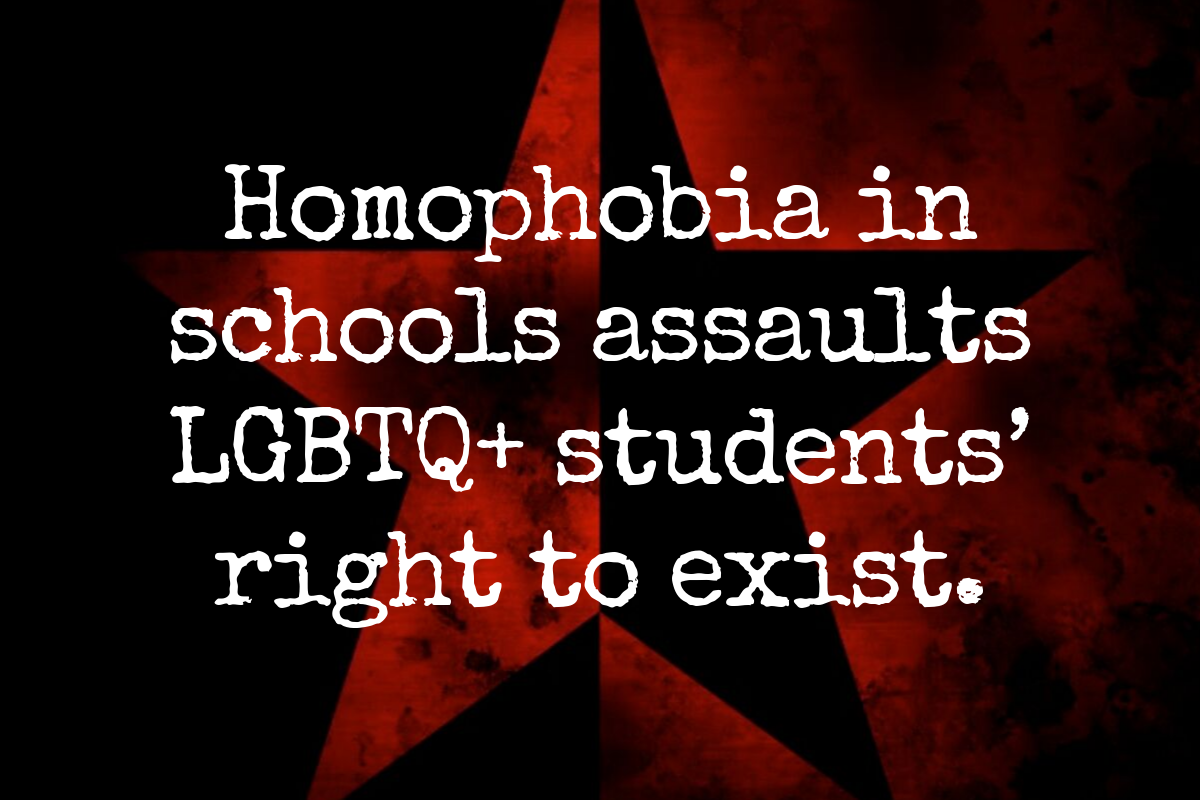
By Gilda L. Ochoa, Enrique C. Ochoa and Sebastián Ochoa-Kaup
Homophobia in schools assaults LGBTQ+ students’ right to exist. Schools must act now to stop it and improve campus climates. It is California law.
Earlier this month at the Kern High School District Board meeting, students recounted homophobic experiences and decried the lack of policies and actions to create inclusive schools. They advocated for the creation of a district-wide student-led committee to address discrimination and bullying of LGBTQ+ students on campus. This call came a week after students from the Future Farmers of America (FFA) in Bakersfield were reported to have confronted classmates at a Gay-Straight Alliance meeting with MAGA flags and homophobic taunts about which types of relationships are so-called right.
The Kern High School district characterized these assaults as “varying viewpoints and opinions.” District officials wrote that their schools aim “to teach students how to communicate respectfully.” This framing minimizes the severity of the issues, and it assumes that all viewpoints are equal, even those that attack people for who they are and how they express themselves. Blatant bullying fuels a toxic campus climate and contributes to gender violence in our schools and society. California law requires schools to “provide all students with a safe, supportive and inclusive learning environment, free from discrimination, harassment, and bullying.” Schools are in violation of this law when this does not occur.
Reports of what is happening in Bakersfield are the latest example of attacks on LGBTQ+ community members to make the headlines. Thankfully, the affected students and their parents have called out these actions. However, everyday LGBTQ+ students, staff and educators encounter attacks on their identities, or they must contend with more covert taken-for-granted school practices that reinforce trans and homophobic practices. While blatant forms of hate receive much of the media attention, individual actions, school policies and district cultures are also responsible for fueling hostile campus climates.
In the Central Valley community of Denair, in early August, a teacher was stopped by the principal for passing out a Gender Unicorn Worksheet to their science class that was to be used to introduce themself and explain why they prefer to be called Mx. and not Mr. The principal’s action denied the teacher this right, and it squelched a learning opportunity for students about the social construction of gender, gender binaries, and gender fluidity. Most recently, critics of the California ethnic studies model curriculum have publicly ridiculed lessons on cis-heteropatriarchy. Such anti-educational messages silence and marginalize, breeding further ignorance, hate, and inequality.
Campus climates have life and death consequences. According to the Human Rights Campaign: bullying and harassment, family rejection and neglect have led to the death of many LGBTQ youth, and “these risks are compounded for LGBTQ youth of color at the intersections of racism, transphobia, biphobia and homophobia.” A recent study published by the American Academy of Pediatrics finds alarming rates of suicide attempts by transgender boys and non-binary youth. LGBTQ+ youth in general have a higher rate of suicide attempts than non-LGBTQ+ youth. Transphobic and homophobic bullying increases the suicide risk factors.
Stemming from decades of organizing, California has among the most progressive policies affirming the rights of LGBTQ+ Californians. Yet, the state has failed to enforce laws and to provide the education necessary to create a supportive gender inclusive state. California law requires schools to provide a safe environment free of bullying and the Department of Education outlines the types of harassment and abuse faced by transgender students. In 2011, California enacted the FAIR Education Act that requires textbooks to include the history and contributions of LGBTQ+ in textbooks and social studies curriculum; and in 2016, it passed the California Healthy Youth Act mandating that schools teach comprehensive sexual health education.
Despite these important steps, many teachers, administrators, and district officials still have not received training in gender studies, LGBTQ+ history, and intersectionality. The 2019 Safe and Supportive Schools Report Card —completed by less than half of all California school districts— found that 35% of the responding districts did not offer any employee training that “generally covers diversity, anti-bias, cultural competency, and/or equity and inclusion.”
Fortunately, there are resources that must be made available to school personnel, parents, and students. Gay Straight Alliance clubs at schools across the state and nation help provide LGBTQ+ students and their allies with safer, more accessible campus climates. The Human Rights Campaign provides resources on their website on how to make schools more gender inclusive, and GLSEN provides resources for K-12 including gender inclusive curriculum.
Schools must be affirming places. However, despite decades of LGBTQ+ activists pushing for change, this is still not the case in 2019. It is long-past time that California laws supporting LGBTQ+ students and requiring schools to teach about the history and struggles of their communities be implemented. When toxic campus climates remain unnamed, unaddressed and are allowed to fester, educators and district officials are complicit and must be held responsible.
***
Gilda L. Ochoa is professor of Chicana/o-Latina/o Studies at Pomona College. Her most recent book is Academic Profiling: Latinos, Asian Americans and the Achievement Gap.
Enrique C. Ochoa is a professor of Latin American Studies and History at California State University, Los Angeles. He has worked with K-12 teachers, students, parents, and administrators to implement Ethnic and Gender Studies in our schools.
Sebastian Ochoa-Kaup is a community activist and educator and has worked with survivors of sexual and domestic violence, people who are HIV+, and the LGBTQ+ community. He is the former director of San Francisco State University’s Queer and Trans Resource Center and frequently presents on issues facing the LGBTQ+ community.


